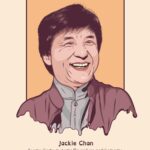Bruce Lee, a legendary figure in martial arts and cinema, was a multilingual talent whose linguistic skills complemented his diverse cultural background and artistic endeavors. Born on November 27, 1940, in San Francisco, Lee was raised in Hong Kong before returning to the United States for higher education. This multicultural upbringing significantly influenced the languages he spoke and the films he created.

Early Life and Linguistic Foundations
Lee was born to a Cantonese Chinese-speaking family. His father, Lee Hoi-chuen, was a Cantonese opera star, which naturally made Cantonese Lee’s first language. Growing up in Hong Kong, a British colony at the time, he was also exposed to English, though it wasn’t his primary language during his early years.
English Proficiency and American Life
In 1959, at the age of 18, Lee moved to the United States to claim his U.S. citizenship and further his education. He attended the University of Washington, majoring in philosophy. This period marked a significant improvement in his English proficiency. Lee’s time in America was pivotal in shaping his linguistic abilities, as he immersed himself in an English-speaking environment both academically and socially.
Career in Film and Television
Lee’s film career began in Hong Kong, where he appeared in several Cantonese-language films as a child actor due to his father’s connections in the entertainment industry. However, it was his return to the U.S. and his subsequent work in Hollywood that cemented his international fame.
In Hollywood, Lee initially struggled due to limited roles available for Asian actors. His breakthrough came with the TV series The Green Hornet (1966-1967), where he played Kato. The show was in English, and Lee’s fluency greatly contributed to his performance.
International Fame and Bilingual Films
Lee’s most iconic films were produced later in his career, combining his linguistic skills and martial arts prowess. These films include The Big Boss (1971), Fist of Fury (1972), Way of the Dragon (1972), and Enter the Dragon (1973). While The Big Boss and Fist of Fury were primarily in Cantonese, Way of the Dragon, which Lee wrote and directed, featured a mix of Cantonese and English, reflecting Lee’s bilingual abilities.
Enter the Dragon co-produced by Warner Bros. and Golden Harvest, was Lee’s first film in the English language and is often credited with having paved the way for mixed martial arts (MMA). This film showcased not only his martial arts skills but also his ability to perform in English, catering to both Eastern and Western audiences.

Pictured: Warner Bros. Studio Big Bang Theory Set
Legacy and Impact

Lee’s proficiency in both Cantonese Chinese and English allowed him to bridge East and West, making him a global icon. His films were often dubbed in multiple languages, further extending his reach. More importantly, his ability to speak and act in different languages enabled him to break stereotypes and open doors for future generations of Asian actors in Western cinema. This includes actors like Jackie Chan, Pat Morita, George Takei and Lucy Liu.
In summary, Bruce Lee was fluent in Cantonese and English, and his films were primarily made in these languages. His linguistic versatility was a key component of his international appeal and success, allowing him to communicate effectively with a diverse audience and to embody the fusion of Eastern and Western cultures. Lee’s legacy in film and martial arts is not only marked by his physical prowess but also by his linguistic abilities, which played a significant role in his groundbreaking career.
Which languages are spoken in Hong Kong?
Hong Kong is a multilingual region where several languages are spoken. The primary languages are:
- Cantonese: This is the most widely spoken language in Hong Kong. It is used in daily conversation, media, and is the language of instruction in schools.
- English: English is also an official language in Hong Kong and is widely used in government, legal affairs, business, and in the educational system. It’s prevalent in signage and public transportation as well.
- Mandarin: With the increasing influence of mainland China, Mandarin has grown in prominence in Hong Kong. It is taught in schools and is becoming more widely spoken and understood, particularly among the younger generation.
- Other Chinese Dialects: Besides Cantonese and Mandarin, other Chinese dialects like Hakka and Shanghainese are spoken by minority groups within the population.
About the Cantonese Chinese Language
Cantonese, a vibrant Chinese language, is renowned for its rich tonal variations and expressive inflections. Predominantly spoken in Hong Kong and Guangdong Province, it is characterized by its unique pronunciation, complex characters, and cultural significance, making it a distinctive and influential part of the Chinese linguistic landscape.

